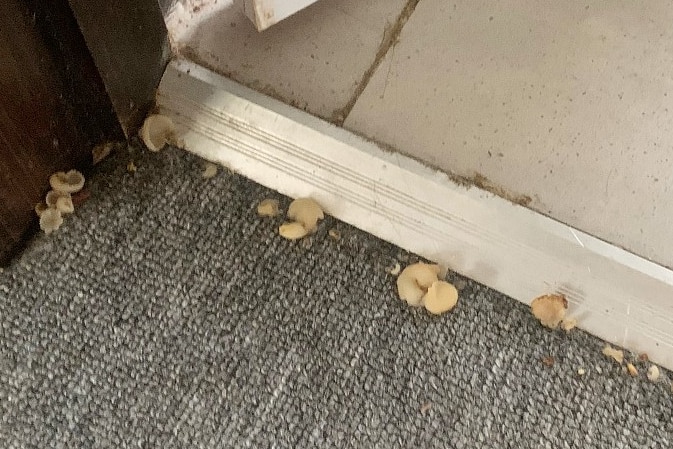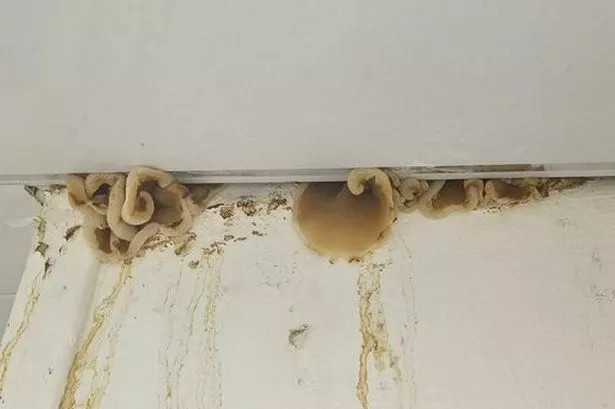Mushrooms growing indoors typically indicate a moisture issue or high humidity within the house. They thrive in damp, dark environments, often appearing due to water leaks, excessive humidity, or poor ventilation. The presence of mushrooms might signal problems like leaking pipes, roof leaks, or inadequate airflow, creating a conducive environment for fungal growth. This growth can lead to structural damage, health risks from mold, and an overall unhealthy living space.
To address this, start by identifying and fixing the source of moisture, repairing leaks, improving ventilation, and using dehumidifiers as needed. Safely remove visible mushrooms, clean affected areas thoroughly, and disinfect surfaces.
How do moisture, organic matter, and poor ventilation lead to indoor mushrooms?

Addressing these factors involves identifying and remedying sources of moisture, improving ventilation, and removing decaying organic matter to prevent and mitigate indoor mushroom growth effectively.
Excessive Moisture
Water Leaks (Pipes, Roofs)
Leaking pipes, roofs, or any form of water intrusion contribute significantly to indoor mushroom growth. These leaks create pockets of moisture in building materials like drywall, wood, or insulation.
Moisture seepage fosters an environment suitable for mushroom spores to develop and thrive. Over time, if these leaks go unnoticed or unresolved, they can lead to persistent fungal growth, including mushrooms.
High Humidity Levels
High levels of indoor humidity create a breeding ground for mushrooms. When the air is excessively humid, it can saturate surfaces, causing moisture accumulation. Areas prone to humidity, such as basements, bathrooms, or poorly ventilated spaces, become favorable environments for mushrooms to grow due to the constant presence of moisture in the air and on surfaces.
Presence of Organic Matter
Decaying Materials
Indoor mushroom growth often occurs in the presence of decaying organic matter. For instance, wood, paper, drywall, or other organic materials can decompose due to water exposure or leaks, providing nourishment for mushroom spores.
As these materials decay, they release nutrients that fungi, including mushrooms, can feed on, facilitating their growth.
Suitable Environment for Mushroom Growth
Mushrooms thrive in environments where organic matter is abundant and moisture levels are optimal. The breakdown of organic material in a moist environment creates conditions conducive to the growth of mushrooms.
The presence of such materials, combined with adequate moisture, creates an ideal habitat for mushroom spores to germinate and form visible fruiting bodies.
Poor Ventilation
Inadequate Airflow Trapping Moisture
Spaces with poor ventilation struggle to circulate air effectively, leading to stagnant air pockets. Inadequate airflow traps moisture indoors, especially in areas with higher humidity levels or water leaks.
This trapped moisture settles on surfaces, promoting fungal growth, including mushrooms, as it provides the necessary moisture for spores to develop.
Conducive to Fungal Growth
Insufficient ventilation exacerbates the moisture problem indoors. The lack of proper air circulation prevents the evaporation of excess moisture, creating an environment conducive to fungal growth. Stagnant air and trapped moisture enhance the likelihood of mushrooms appearing in these spaces due to the sustained dampness ideal for their growth.
What are the risks from indoor mushroom growth?
Addressing indoor mushroom growth promptly and effectively is essential to safeguard the structural integrity of the building, protect the health of occupants, and restore a healthy indoor environment.
Structural Damage
Mushrooms growing indoors can pose significant risks to a building’s structural integrity. Fungal growth, including mushrooms, feeds on organic materials like wood, drywall, and insulation. As they thrive, they break down these structural components, compromising their strength and durability.
Over time, this decay can lead to weakened structures, sagging ceilings, warped floors, and even structural collapses in severe cases. Addressing the root cause of indoor mushroom growth becomes crucial to prevent substantial and costly structural damage.
Health Risks from Mold and Fungi
Indoor mushrooms often accompany mold and fungi, posing health risks to occupants. As mushrooms are fungi themselves, their presence signifies an environment conducive to other potentially harmful molds. Mold spores and fungal particles released by mushrooms can trigger allergic reactions, respiratory issues, and aggravate existing health conditions like asthma or allergies.
Moreover, certain species of indoor mushrooms might be toxic if ingested, posing a direct health threat. Proper remediation and removal of indoor mushrooms are vital to mitigate these health risks.
Overall Negative Impact on Indoor Environment
The growth of mushrooms indoors signifies an unhealthy indoor environment. It reflects underlying issues like moisture intrusion, poor ventilation, or decaying organic matter. This not only affects the structural integrity of the building but also creates an uncomfortable living space.
The presence of mushrooms can cause unpleasant odors, visual distress, and overall discomfort for occupants. Furthermore, it may impact the property’s value and aesthetics, creating a negative impression for inhabitants and visitors alike.
What steps address indoor mushroom growth?

Implementing these comprehensive actions to address indoor mushroom growth effectively targets the root causes, eliminates moisture sources, prevents further fungal development, and restores a healthier indoor environment.
Identifying the Source of Moisture
Thoroughly examine the property for any signs of water leaks, including checking plumbing, roofs, windows, and basements. Look for stains, discoloration, or visible moisture on walls, ceilings, and floors. Damp areas such as around sinks, showers, or near appliances should also be inspected for potential leaks contributing to moisture buildup.
Evaluate the effectiveness of ventilation systems within the property. Proper ventilation helps regulate indoor humidity levels by allowing the exchange of indoor and outdoor air. Assess exhaust fans in bathrooms and kitchens, ensure proper attic ventilation, and check air circulation in all rooms to identify areas with inadequate airflow.
Remedial Actions
Promptly repair any identified leaks to prevent further water intrusion. Fix plumbing issues, roof leaks, or damaged seals. Improving ventilation might involve installing or upgrading ventilation systems, ensuring air circulation, and using exhaust fans where necessary. Enhancing airflow helps reduce moisture accumulation and inhibits favorable conditions for mushroom growth.
Utilize dehumidifiers in areas prone to high humidity levels. Dehumidifiers extract excess moisture from the air, helping maintain optimal humidity levels and inhibiting fungal growth. Additionally, employing moisture control measures such as sealing cracks, using moisture-resistant paints, and employing moisture-absorbing materials can help prevent moisture buildup.
Removal and Cleaning
Safely remove visible mushrooms using gloves and a mask to avoid direct contact. Carefully pluck or cut them at the base, ensuring complete removal. Dispose of them properly, preferably by sealing in a plastic bag before disposal, to prevent spores from spreading.
Clean affected areas with a solution containing soap or detergent and water to remove any remaining spores, stains, or residue. Use a scrub brush or sponge to clean surfaces thoroughly, especially where mushrooms were present.
After cleaning, use a disinfectant to treat surfaces where mushrooms were found. Disinfectants help kill remaining spores and inhibit further fungal growth. Follow manufacturer instructions and safety guidelines when using disinfectants.
FAQ’s
How can a mushroom appear to grow overnight?
Mushrooms seemingly grow quickly due to rapid spore germination and mycelium development in suitable conditions like high humidity and proper temperature, enabling swift visible growth.
Why is there a mushroom in my bathroom?
Discovering a mushroom in your bathroom might indicate excess moisture from showers or leaks, creating a damp environment ideal for mushroom growth.
What fungus grows overnight?
Various fungi, including some molds and certain mushroom species, can appear to grow rapidly overnight under favorable conditions.
How many days does a mushroom live?
The lifespan of a mushroom varies, but generally, they last from a few days to approximately a week or more, contingent upon environmental factors and species.
What is the first stage of mushroom growth?
The initial stage of mushroom growth begins with spore germination, where spores develop into mycelium, the fungal network that later forms the visible fruiting body of the mushroom.
Can a mushroom be left overnight?
Yes, mushrooms can be left overnight, but their lifespan depends on various factors such as moisture levels, temperature, and the specific species of the mushroom.
Final Words
When mushrooms grow indoors, it’s a sign of too much moisture in the house. These mushrooms can be a big problem because they often come from leaks or places with too much dampness. They can cause damage to the structure of your home, which might cost a lot to fix. Not only that, but they can also make people sick because they sometimes bring along other things like mold that’s bad for health.
To fix this, it’s important to find and stop the source of the moisture, like leaks or too much humidity. Repairing these issues, improving ventilation, and keeping things dry are key steps. Removing the visible mushrooms safely, cleaning affected areas well, and disinfecting surfaces are important to prevent more mushrooms from growing.
